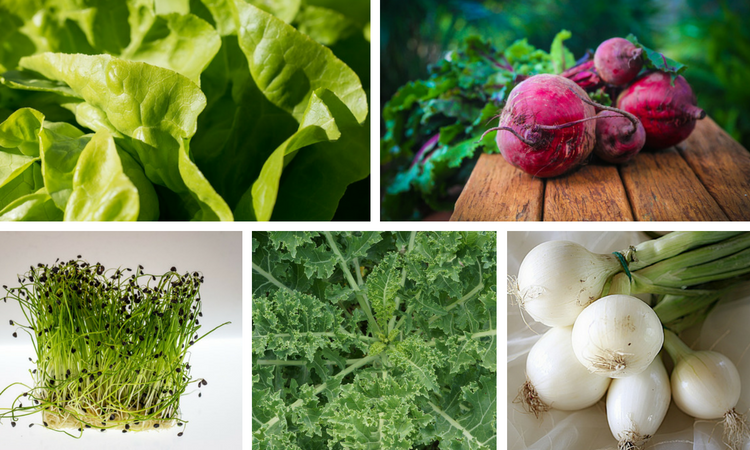
[adinserter block=”1″]
Microgreens are rapidly gaining in popularity, quickly making the transition from the fine dining world into the mainstream. For those who don’t know, microgreens are miniature vegetable, herb, and green plants.
They pack more flavor than sprouts and offer more nutritional value than regular greens. If all that weren’t enough, they are also incredibly easy to grow inside and cost very little to maintain.
Sounds pretty great, right? Then check out the 10 best microgreens you can start growing today.
[adinserter block=”4″]

1. Lettuce
What could be better than having freshly grown lettuce in your home all year long? Lettuce microgreens are relatively easy to grow and very convenient to have in your home. These microgreens are a flavorful and crisp addition to any salad.
The vibrant color also makes this a great garnish for any dish. Lettuce seeds are the perfect beginner plant for anyone just becoming interested in growing microgreens.
2. Kale
Kale seems to be the vegetable of the moment right now. Of course, its microform is no exception. Kale grows quickly and produces succulent leaves. Though technically you can grow microgreens in any weather, kale tends to fair better in colder temperatures.
There are many different types and colors of kale. Some are bitter and peppery, others are sweeter, but all of them are super tasty and can be grown in your micro garden.
3. Beets
These microgreens are known for their beautiful appearance. This is mainly due to their bright red and green stems. In addition to their vibrant color and visual appeal, beets also pack in a great amount of vitamins, calcium, and protein.
Beets take a bit longer to sprout, usually between one and three weeks. These colorful microgreens would look stunning in any garden and on any plate.
Related: 12 Plants That Grow Well In The Shade
4. Radish
Radishes come in a number of surprisingly flavorful varieties. Some of these are as hot and pungent as a fully grown radish root. They also grow in a number of colors like, green, pinkish red, and purple.
The darker the color of the radish, the higher the concentration of vitamins, antioxidants, and minerals. Triton, Red Arrow, Sango, and Japanese Daikon are all popular types of radish microgreens.
[adinserter block=”2″]
5. Cress
Some people praise cress as being the perfect microgreen. It is one of the oldest types of microgreen and has been used in salads and sandwiches for many years. These little plants pack some serious flavor too.
Cress has a complex, spicy, and peppery taste. This makes it the perfect addition to any soup, sandwich, or appetizer. Along with its taste, cress is known for its distinct and beautiful leaves. Once planted, the seeds usually sprout within a week.
6. Onions
These little onions will never make you cry, even when you are cutting them up. These microgreens are monocots, similar to wheat grass. They take about a month to mature. You harvest them by cutting off the top one to two inches.
Then, you can harvest the same batch a few more times as the plant continues to grow. Onion microgreens have a grass-like appearance, but they taste just like regular onions. Even when they are small, onions are often an essential and flavorful ingredient in any dish.
7. Spinach
Grow a garden that would make Popeye proud with spinach microgreens. These little plants have a mild flavor and dark green leaves. Those leaves, however, hold a ton of nutritional value.
Much like mature spinach, these microgreens are a wonderful source of iron, potassium, and calcium. They also provide your body with a ton of vitamins A and C. Spinach is another cool season crop.
Higher temperatures can cause a large portion of your seeds to fail to germinate. This, in turn, can cause them to rot in the microgreen system and spread disease.
8. Mustard
Along with cress, mustard is another one of the oldest microgreens. Mustard has a sharp, peppery flavor that goes great in sandwiches and salads. Mustard greens taste similar to horseradish, although, there are other variety of mustard microgreens too.
Osaka Purple has beautiful purple stems and Red Giant has vibrant reddish leaves. All varieties are as pungent as you would expect mustard to be. They are ready to be harvested in around two weeks when the first leaves begin to appear.
Related: 15 Epic Hacks For The Most Successful Vegetable Garden Ever
9. Basil
Basil is the staple of any herb garden and now, you can grow it in microform too. Your taste buds will definitely take notice of these aromatic microgreens, not matter what dish they are in.
In addition to their distinct flavor, these microgreens hold a lot of nutritional value, such as iron, potassium, zinc, and vitamins A, B, C, E, and K. Basil is one of the most difficult microgreens to grow, so you need to have a lot of patience before you can enjoy this herb.
These seeds take longer to germinate than most other microgreens, between two and three weeks. These little plants, however, are worth the effort!
10. Chia
Chia is a very nutritious and easy to grow microgreen. Chia is high in calcium, manganese, antioxidants, and fiber. They are also a great source of protein. They offer large amounts of nutritional benefits while still remaining low in calories.
They are very easy to grow and usually are ready to harvest in five to fourteen days. Add chia seeds to your micro garden, or better yet, dust off that old chia pet in your attic.
Start Growing Microgreens in Your House Today
Growing microgreens is an easy, convenient, and fun way to bring fresh food into your home. There are a number of different microgreen plants that you can choose from to include in your indoor garden.
For beginners, you will want to start with something easy, like chia or kale. For experienced growers, beets and basil microgreens will be more your speed.
No matter what your gardening skill level is or what your taste preferences are, there is a microgreen for you. Start your mini garden today and you too could be eating fresh produce all year round!


